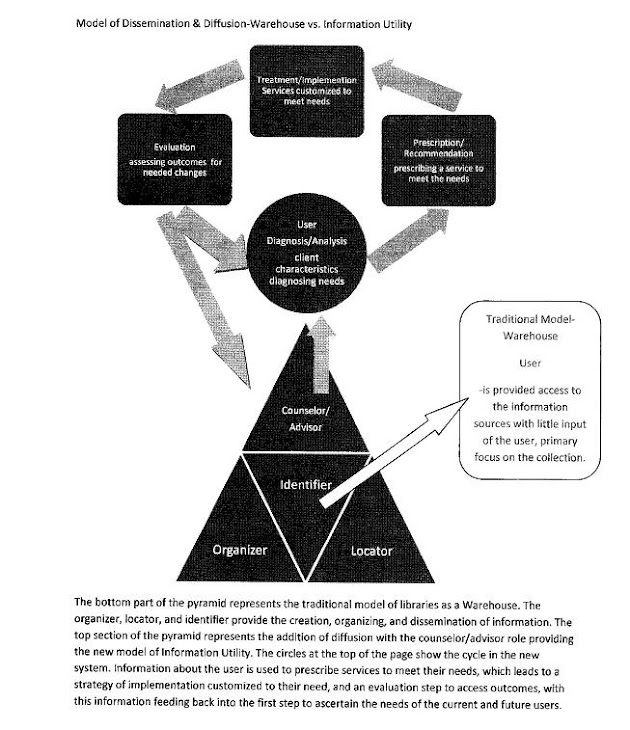Friday, March 7, 2008
Promoting Distance Learning
Systems thinking-he used all of the following strategies to promote library services to distance learning faculty-an introductory email, a hard copy letter, a personal telephone call, a personal office visit, and follow-up emails as services changed. He was disappointed in the response and decided to amend the strategies by including as much in-person promotion as possible, include as much as possible other librarians to promote the service, and continue the written letters and emails but not necessarily as the first step. He saw the exercise as a continuously evolving system.
Process Mapping-with the Distance Learning Librarian in the center of the map the flow can change and flow in any direction. Formal and informal promotion is included in the map’s structure. The distance learning faculty, Distance Learning Dean, the Dean of the Library, and individual librarians among others are pieces of the map.
Team Learning Initiatives- using the work of Senge, Kleiner, Ross, & Smith (1994) in their book The Fifth Discipline Fieldbook: Strategies and Tools for Building a Learning Organization, you identify team members and design the team learning agenda. First, have the team members discuss what they want and how to accomplish it. Second, discuss the current situation and decide if you aspirations can be realistically met. Third, identify team knowledge and expertise and use them where they will be most beneficial. Fourth, make sure your team actually has the desire and commitment for learning.
Diffusion of Innovation Practices-the heart of any service is the positive qualities of the team which he list as enthusiasm, knowledge, organizational skills and excellent service attitude. To these are added knowledge of the audience served and a recognition of the learning styles of distance learners which is integrated with all aspects of the service including procedures, web pages, communication practices, and library instruction.
These 4 processes are used together to come up with the most effective way to promote a distance learning service.
Wyss, P.A. (2007, December). Solving the problem of promoting distance library services.
College Student Journal, 41(4), 747-754. Retrieved March 5, 2008, from Academic Search Complete database.
So what do you think. Are there ways to improve on these techniques to promote the library in distance learning? How about finding ways to directly involve the students in the process?
Tuesday, March 4, 2008
Information Power in schools
Teaching and helping individuals learn information literacy skills are a very important part of dissemination and diffusion. Lesley Farmer (2002) in an article in Teacher Librarian talks about helping to make this more effective in schools with what she calls a research-based cycle of inquiry.
The process she recommends requires an across the school curriculum examination and development of a literacy skills program. The American Association of School Librarians has developed nine information literacy standards which include among others standard bibliographical instruction, locating and using information for both personal and academic uses, and ethical use. But to get past the traditional idea of information literacy as an add-on or separate entity the teacher-librarian needs to translate this into the specific language of each discipline. The more they understand the subject-area teachers’ perspective on this issue the more they can make it an integral element of education.
Farmer describes the cycle of inquiry as a seven step process.
- Define the desired outcome: information literate students
- Identify the outcome “gaps”: look at both the process and product. The librarian should talk to the teachers and the students to clarify questions about the entire process, to help identify the origins of information literacy problems leading to intervention.
- Describe the current practice relative to the outcome: librarians need to see the students’ final projects and the assignment itself. The assignment sheet helps identify the competencies expected of students, is it clear? Does it assume skills the students do not have? By examining final papers they can see what areas need work. They can also communicate across the curriculum to facilitate collaboration.
- Determine the possible reasons for the gaps: teachers can state the degree to which they incorporate information literacy in their project and then an information literacy “grid” can be developed to compare projects, competencies, and what is addressed at each grade level for each subject-area. This identifies what is being taught, reinforced, and what needs to be addressed.
- Identify and develop interventions targeted to address the gaps: the previous steps must be carried out in a systematic way and although this involves significant time it optimizes decision-making and implementation of the program.
- Implement the interventions
- Assess the results: how are the results manifested? By presenting clearer assignments, complete and accurate bibliographies in research papers, less plagiarism, and improved student work.
The research-based cycle of inquiry is a continuous cycle. Through this cycle Farmer (2002) states, “that the true power of information power reveals itself: lifelong learning that uses information in meaningful ways to transform individuals and society” (24).
I have always felt that if you teach someone how and where to find the answers to questions and how to evaluate what they find, then they can be well educated no matter what formal level of education they achieve. This is more important than any facts you can stuff into their heads. So to me information literacy should be the center of education not simply an add-on. What do you think?
Farmer, L. (2002, February). Harnessing the power in information power. Teacher
Information Science Full Text database.

